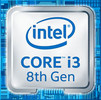AMD Ryzen 5 5600U vs Intel Core i3-8100H vs Intel Core i9-9880H
AMD Ryzen 5 5600U
► remove from comparison
The AMD Ryzen 5 5600U, not to be confused with Intel's Core i7-5600U, is a fairly fast Cezanne family processor designed for use in thinner, lighter laptops. The R5 5600U integrates six of the eight cores based on the Zen 3 microarchitecture and is the third fastest U-series processor at launch. The cores are clocked at 2.3 (guaranteed base clock) to 4.2 GHz (Turbo) and support SMT for a total of 12 threads. The chip is manufactured on the modern 7 nm TSMC process.
The new Zen 3 microarchitecture offers a significantly higher IPC (instructions per clock) compared to Zen 2. For desktop processors AMD claims 19 percent on average and in applications reviews showed around 12% gains at the same clock speed.
In addition to the six CPU cores, the APU also integrates a Radeon RX Vega 7 integrated graphics card with 7 CUs at up to 1800 MHz. The dual channel memory controller supports DDR4-3200 and energy efficient LPDDR4-4266 RAM. Furthermore, 16 MB level 3 cache (up from 8 MB at the 4800U) can be found on the chip.
Performance
This Ryzen 5 series chip is a solid mid-range CPU, as of early 2022. Its multi-thread benchmark scores nearly match those of the Intel Core i5-11400H (a much more power-hungry hexa-core chip designed for use in gaming laptops). While not nearly as fast as 12th generation Alder Lake-P processors, the 5600U should be good enough for the vast majority of users.
Thanks to its decent cooling solution and a long-term CPU power limit of 30 W, the IdeaPad 5 Pro 14ACN6 is among the fastest laptops powered by the 5600U that we know of. It can be more than 30% faster in CPU-bound workloads than the slowest system featuring the same chip in our database, as of August 2023.
Power consumption
This Ryzen 5 has a default TDP of 15 W, a value that laptop makers are allowed to change to anything between 10 W and 25 W with clock speeds and performance changing accordingly as a result. By going for the lowest value possible, it is possible to build a passively cooled system around this chip. Most laptop makers, however, will do the opposite to maximize performance.
The AMD Ryzen 5 5600U is built with TSMC's 7 nm manufacturing process for average, as of mid 2023, energy efficiency.
Intel Core i3-8100H
► remove from comparison
The Intel Core i3-8100H is a mid-range processor for laptops with four cores based on the Coffee Lake architecture and was announced mid 2018. The processor clocks at 3 GHz (no Turbo Boost) and can execute up to four threads simultaneously (no Hyper-Threading). According to Intel, the CPU is manufactured in an improved 14nm (14nm++) process.
The Coffee Lake architecture is similar to Kaby Lake and differs only in the amount of cores (now six cores for the high end versions) and the improved 14nm process (14nm++ according to Intel).
Graphics
The integrated Intel UHD Graphics 630 iGPU is supposed to offer a slightly higher performance as its clock rate has been increased by 50 MHz (rumored). The architecture is identical to that of the Intel HD Graphics 630. We do expect a performance improvement, but as a low-end solution it will probably only display current games smoothly at reduced details - if at all.
Power Consumption
Intel specifies the TDP with 45 watts and therefore the i5 is only suited for big laptops with good cooling solutions. Using cTDP-down, the CPU can also be configured to 35 Watt resulting in a reduced performance.
Intel Core i9-9880H
► remove from comparisonThe Intel Core i9-9880H is a high-end processor for laptops with eight cores based on the Coffee Lake architecture (2019 refresh, CFL-HR). The processor clocks at between 2.3 - 4.8 GHz (4.1 GHz with 8 cores) and can execute up to sixteen threads simultaneously thanks to Hyper-Threading. The 4.8 GHz can only be reached using the "Thermal Velocity Boost" which allows one core to boost to 4.8 GHz (+200 MHz) as long as the CPU temperature is below 50°C. Multiple cores can be boosted +100 MHz below 50°C (not verified). Compared to the predecessor, the Core i9-8950HK, the 9980H is based on the same architecture but offers 2 more cores.
According to Intel, the CPU is manufactured in an improved 14nm (14nm++) process. The i9-8950HK is the fastest model of the Coffee-Lake-H series at the time of announcement and offers an unlocked multiplier for overclocking of the CPU.
The Coffee Lake architecture is similar to Kaby Lake and differs only in the amount of cores (now six cores for the high end versions) and the improved 14nm process (14nm++ according to Intel).
Performance
Due to the two additional cores, performance has increased by almost 33% compared to a similar clocked predecessor and even up to 100% compared to older Kaby-Lake quad-cores. Single thread performance however only improved slightly and the multi-core performance is heavily depending on the cooling.
Graphics
The integrated Intel UHD Graphics 630 iGPU is supposed to offer a slightly higher performance as its clock rate has been increased by 50 MHz. The architecture is identical to that of the Intel HD Graphics 630. We do expect a performance improvement, but as a low-end solution it will probably only display current games smoothly at reduced details - if at all.
Power Consumption
Intel specifies the TDP with 45 watts and therefore the i9 is only suited for big laptops with good cooling solutions.
| Model | AMD Ryzen 5 5600U | Intel Core i3-8100H | Intel Core i9-9880H | ||||||||||||||||||||||||||||||||||||||||||||||||||||||||||||||||||||||||||||||||||||||||||||||||||||||||||||||||||||||||||||||||||||||||||||||||
| Codename | Cezanne-U (Zen 3) | Coffee Lake-H | Coffee Lake-H | ||||||||||||||||||||||||||||||||||||||||||||||||||||||||||||||||||||||||||||||||||||||||||||||||||||||||||||||||||||||||||||||||||||||||||||||||
| Series | AMD Cezanne (Zen 3, Ryzen 5000) | Intel Coffee Lake | Intel Coffee Lake | ||||||||||||||||||||||||||||||||||||||||||||||||||||||||||||||||||||||||||||||||||||||||||||||||||||||||||||||||||||||||||||||||||||||||||||||||
| Series: Coffee Lake Coffee Lake-H |
|
|
| ||||||||||||||||||||||||||||||||||||||||||||||||||||||||||||||||||||||||||||||||||||||||||||||||||||||||||||||||||||||||||||||||||||||||||||||||
| Clock | 2300 - 4200 MHz | 3000 MHz | 2300 - 4800 MHz | ||||||||||||||||||||||||||||||||||||||||||||||||||||||||||||||||||||||||||||||||||||||||||||||||||||||||||||||||||||||||||||||||||||||||||||||||
| L1 Cache | 384 KB | 256 KB | 512 KB | ||||||||||||||||||||||||||||||||||||||||||||||||||||||||||||||||||||||||||||||||||||||||||||||||||||||||||||||||||||||||||||||||||||||||||||||||
| L2 Cache | 3 MB | 1 MB | 2 MB | ||||||||||||||||||||||||||||||||||||||||||||||||||||||||||||||||||||||||||||||||||||||||||||||||||||||||||||||||||||||||||||||||||||||||||||||||
| L3 Cache | 16 MB | 8 MB | 16 MB | ||||||||||||||||||||||||||||||||||||||||||||||||||||||||||||||||||||||||||||||||||||||||||||||||||||||||||||||||||||||||||||||||||||||||||||||||
| Cores / Threads | 6 / 12 | 4 / 4 | 8 / 16 | ||||||||||||||||||||||||||||||||||||||||||||||||||||||||||||||||||||||||||||||||||||||||||||||||||||||||||||||||||||||||||||||||||||||||||||||||
| TDP | 25 Watt | 45 Watt | 45 Watt | ||||||||||||||||||||||||||||||||||||||||||||||||||||||||||||||||||||||||||||||||||||||||||||||||||||||||||||||||||||||||||||||||||||||||||||||||
| Technology | 7 nm | 14 nm | 14 nm | ||||||||||||||||||||||||||||||||||||||||||||||||||||||||||||||||||||||||||||||||||||||||||||||||||||||||||||||||||||||||||||||||||||||||||||||||
| max. Temp. | 105 °C | 100 °C | 100 °C | ||||||||||||||||||||||||||||||||||||||||||||||||||||||||||||||||||||||||||||||||||||||||||||||||||||||||||||||||||||||||||||||||||||||||||||||||
| Socket | FP6 | FCBGA1440 | FCBGA1440 | ||||||||||||||||||||||||||||||||||||||||||||||||||||||||||||||||||||||||||||||||||||||||||||||||||||||||||||||||||||||||||||||||||||||||||||||||
| Features | DDR4-3200/LPDDR4-4266 RAM, PCIe 3, MMX, SSE, SSE2, SSE3, SSSE3, SSE4A, SSE4.1, SSE4.2, AVX, AVX2, BMI2, ABM, FMA, ADX, SMEP, SMAP, SMT, CPB, AES-NI, RDRAND, RDSEED, SHA, SME | Dual-Channel DDR4 Memory Controller, AVX, AVX2, Quick Sync, Virtualization, AES-NI | Dual-Channel DDR4 Memory Controller, HyperThreading, AVX, AVX2, Quick Sync, Virtualization, AES-NI | ||||||||||||||||||||||||||||||||||||||||||||||||||||||||||||||||||||||||||||||||||||||||||||||||||||||||||||||||||||||||||||||||||||||||||||||||
| iGPU | AMD Radeon RX Vega 7 ( - 1800 MHz) | Intel UHD Graphics 630 (350 - 1000 MHz) | Intel UHD Graphics 630 (350 - 1200 MHz) | ||||||||||||||||||||||||||||||||||||||||||||||||||||||||||||||||||||||||||||||||||||||||||||||||||||||||||||||||||||||||||||||||||||||||||||||||
| Architecture | x86 | x86 | x86 | ||||||||||||||||||||||||||||||||||||||||||||||||||||||||||||||||||||||||||||||||||||||||||||||||||||||||||||||||||||||||||||||||||||||||||||||||
| Announced | |||||||||||||||||||||||||||||||||||||||||||||||||||||||||||||||||||||||||||||||||||||||||||||||||||||||||||||||||||||||||||||||||||||||||||||||||||
| Manufacturer | www.amd.com | ark.intel.com |
Benchmarks
Average Benchmarks AMD Ryzen 5 5600U → 0% n=0
Average Benchmarks Intel Core i9-9880H → 0% n=0
* Smaller numbers mean a higher performance
1 This benchmark is not used for the average calculation












